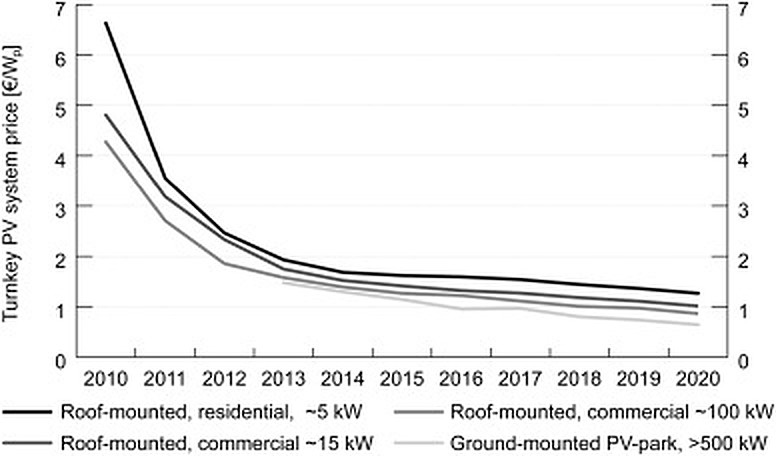The levelized cost of energy (LCOE) of utility scale solar power plants built without subsidies in Sweden reached a value of €0.02737–0.04939/kWh in 2019–20, according to a recent study from Chalmers University of Technology and Uppsala University.
“This is possible thanks to very low cost of capital and the good financing conditions offered by lenders in Sweden,” the research's corresponding author, Johan Lindhal, told pv magazine.
The research group analyzed, in particular, the economic parameters of six solar parks commissioned in the Scandinavian country between 2019 and 2020. The six facilities were built with a capex ranging from €603.20 to €776 per kilowatt installed and a yearly fixed operations and maintenance cost of €4.20 to €9.10/kW installed. Their installed capacity spans from three to 14MW and their expected lifetime is estimated at between 20 and 45 years.
The average debt financing level of the six commissioned PV parks was about 70% with average nominal interest rates of, on average, 2%, which resulted in a nominal cost of capital of about 3.4%, on average, which corresponded to a real weighted-average cost of capital per annum of 1.4%, under a 2% inflation assumption. “In all recent long-term scenario modeling studies done by Swedish authorities and academics, the real interest rates of PV have been assumed to be 5–7%. A 5% and 7% cost of capital – instead of 1.4 % – would increase the LCOE of the studied PV parks from the average of €0.04079/kWh to €0.05785/kWh and €0.06899/kWh, respectively,” Lindhal further explained. “Such a high LCOE for PV parks in Sweden would indeed make them economically unattractive in future power system scenario modeling.”
The scientists specified that the average LCOE value is the result of the individually calculated LCOE values for each plant and not the result of an LCOE calculation with the averages as inputs. Furthermore, the owner of the plants considered a solar module degradation rate varying between 0.2% and 0.4% per year for the six projects, which are located in different geographical areas and across three electricity trading areas.
The project with the lowest LCOE, of €0.02737/kWh, is a plant with an expected lifetime of 45 years, a 2% annual degradation, a capex of €703,758 per megawatt installed, a yearly fixed operations and maintenance cost of €11,277/MW, and a nominal weighted-average cost of capital per annum of 0.2%. The long lifetime, according to the owner, will be possible to reach by two rounds of inverter replacement reinvestment and one reinvestment in a new transformation station, under the lifetime.
By contrast, the solar park with the highest LCOE, of €0.04939/kWh is a facility with a significantly higher nominal weighted-average cost of capital per annum of 3.1% and a life expectancy of 20 years – the lowest among the six projects. Furthermore, it has an estimated annual degradation rate of 0.3%, a capex of €662,912/MW installed, and a yearly fixed operations and maintenance cost of €4,546/MW.
“Size is an important factor for the capex but what this study found out is that, for example, the choice of location and site preparation had a larger influence on capex than size, and that the cost of capital was the most important factor of reaching a low LCOE,” Lindhal emphasized.
“When comparing the LCOE values from six of the PV parks commissioned between 2019 and 2020 in Sweden with the revenues obtained from the spot market and tradable green certificates in 2019 and 2020, we conclude that the profitability of PV parks can be achieved, but are not assured, under a merchant PV business model,” the paper concluded. “This suggests that there must be other direct or indirect economical values obtained through the different ownership structures or business models applied, and indeed, all six parks in the interview study have either been realized under corporate PPA or cooperative ownership business models.”
The findings of the research were presented in the paper “Economic analysis of the early market of centralized photovoltaic parks in Sweden,” published in Renewable Energy.
This content is protected by copyright and may not be reused. If you want to cooperate with us and would like to reuse some of our content, please contact: editors@pv-magazine.com.




10 comments
By submitting this form you agree to pv magazine using your data for the purposes of publishing your comment.
Your personal data will only be disclosed or otherwise transmitted to third parties for the purposes of spam filtering or if this is necessary for technical maintenance of the website. Any other transfer to third parties will not take place unless this is justified on the basis of applicable data protection regulations or if pv magazine is legally obliged to do so.
You may revoke this consent at any time with effect for the future, in which case your personal data will be deleted immediately. Otherwise, your data will be deleted if pv magazine has processed your request or the purpose of data storage is fulfilled.
Further information on data privacy can be found in our Data Protection Policy.